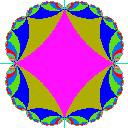

Let B(D,G) denote the set of hyperbolically bounded holomorphic
quadratic differentials on the unit disk D for the Fuchsian group
G uniformizing a once-punctured torus X. This group G
is commensurable with the Fuchsian group G' uniformizing a 4-times
punctured sphere Y. We may assume that Y=C-{0,1,a}, where
C denotes the complex plane. Then Q:=p*(dz2/z(z-1)(z-a)
) forms a basis of the vector space B(D,G), where p:D-->Y
is the canonical projection by the action of G' because B(D,G)
is one-dimensional and coincides with B(D,G').
For a complex number t, we can construct the developing
map
Ft from the unit disk to the Riemann sphere so that
Example (Square Torus)
In the case below, X is the square torus with one point removed,
in other words, the completion of
X is the quotient space of the
complex plane by the lattice group generated by 1 and i. We display
the range {t=u+iv; |u|< A and |v|< A} for each
picture. We can see the Bers embedding of Teichmueller space as a component
of colored regions at the center of pictures.
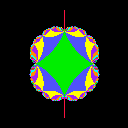 |
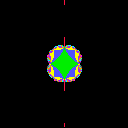 |
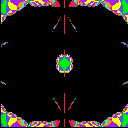 |
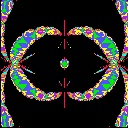 |
| A=.5 | A=1 | A=2 | A=4 |
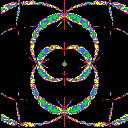 |
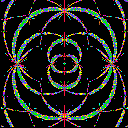 |
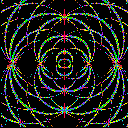 |
|
| A=8 | A=16 | A=32 |
Example 2 (Equilateral Triangle)
In the case below, X has the symmetry under the rotation of order
3, in other words, the completion of
X is the quotient space of
the complex plane by the lattice group generated by 1 and the cubic root
of -1. We display the range {t=u+iv; |u|< A and |v|<
A} for each picture.
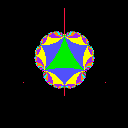 |
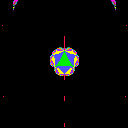 |
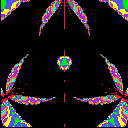 |
| A=.5 | A=1 | A=2 |
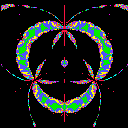 |
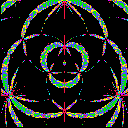 |
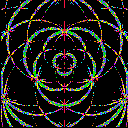 |
| A=4 | A=8 | A=16 |
For any question or comment, please contact us
Related links:
McMullen's Gallery (many beautiful pictures)
Yamashita's Home Page (more pictures)
Wada's OPTi (cool program)
Bers Slice Project (in Japanese)
Bers Slice Project (part 2) (in Japanese)